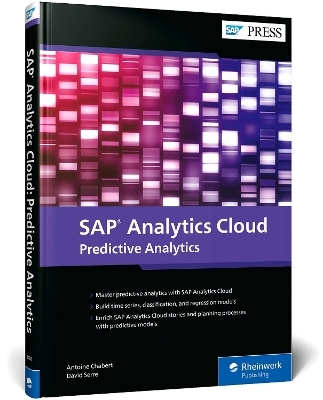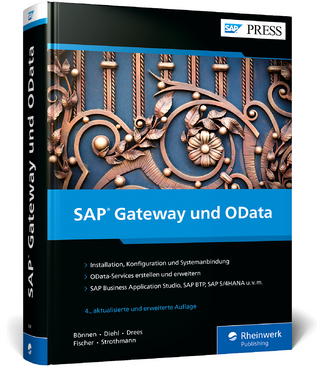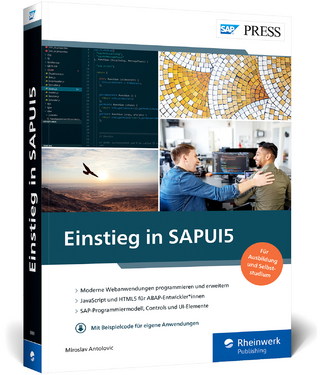
SAP Analytics Cloud
SAP Press (Verlag)
978-1-4932-2478-4 (ISBN)
Today's organizations must be prepared for tomorrow's events. Forecast future behavior in SAP Analytics Cloud with this comprehensive guide to predictive analytics! Start by learning about the data types, scenarios, and methods used in predictive analytics projects. Then follow step-by-step instructions to build, analyze, and apply predictive models to your business data using classification, time series forecasting, and regression analysis. Automate your models and dive into the data science with this all-in-one guide!
In this book, you'll learn about:
a. Predictive Scenarios and Projects
Understand the basics of predictive analytics in SAP Analytics Cloud: scenarios, data types, and actions. Then plan your predictive project, including identifying the key stakeholders and reviewing the methodology.
b. Build, Train, Analyze, and Apply
Master predictive models from end to end. Create classification, time series, and regression models; then train them to identify business patterns. Analyze and apply the results of your models to data in SAP Analytics Cloud.
c. Practical Demonstrations
See predictive analytics in action! Identify use cases for predictive modeling. For each data model, understand practical applications through curated examples with sample business data.
Highlights include:
1) Predictive scenarios
2) Predictive forecasts
3) Data modeling
4) Planning
5) Time series model
6) Classification model
7) Regression model
8) Multi-actions
9) Data science
10) Stories and dashboards
Antoine Chabert is a product manager for SAP Analytics Cloud. He joined SAP more than 16 years ago and developed his expertise in SAP Analytics products, including SAP BusinessObjects, SAP Lumira, SAP Predictive Analytics, and SAP Analytics Cloud, in various functional roles. He helps SAP Analytics Cloud customers get the most out of the product and he works with SAP Engineering to create exciting innovations, connecting predictive analytics, business intelligence, and planning. Antoine holds a master's degree in computer science engineering. Outside of the office, he loves reading, playing badminton, and spending time with his family. David Serre is the product owner of the smart predict capability in SAP Analytics Cloud. He works closely with the product management team to convert customer needs into the features delivered in smart predict. David holds a master's degree in computer science and data exploration. In 2007, he started working as a software developer and later became a product owner for KXEN, an editor of predictive solutions. David joined SAP in 2014 and has worked as product owner for predictive analytics and smart predict since then.
... Preface ... 15
... Objective of This Book ... 15
... Target Audience ... 16
... Structure of This Book ... 16
... Acknowledgments ... 18
... Conclusion ... 19
I ... Getting Started ... 21
1 ... An Introduction to Predictive Analytics in SAP Analytics Cloud ... 23
1.1 ... The Importance of Predictive Analytics ... 23
1.2 ... Predictive Analytics in SAP Analytics Cloud ... 26
1.3 ... Customer Use Cases ... 30
1.4 ... Summary ... 34
2 ... What Are Predictive Scenarios? ... 35
2.1 ... Introducing Predictive Scenarios ... 35
2.2 ... The Different Types of Predictive Scenarios ... 41
2.3 ... The Predictive Ecosystem ... 42
2.4 ... Summary ... 51
3 ... Predictive Analytics Projects ... 53
3.1 ... Predictive Analytics Project Stakeholders ... 53
3.2 ... How to Implement a Predictive Analytics Project ... 56
3.3 ... Summary ... 68
II ... Time Series Forecasting Models ... 69
4 ... Introducing Time Series Forecasting Models ... 71
4.1 ... What Is Time Series Forecasting? ... 71
4.2 ... Data Sources for Time Series Forecasting Models ... 76
4.3 ... End-to-End Time Series Forecasting Workflows ... 82
4.4 ... Summary ... 84
5 ... Using Predictive Forecasts in the Planning Process ... 85
5.1 ... Business Scenario ... 85
5.2 ... Planning Models ... 86
5.3 ... Creating Time Series Forecasting Models with Predictive Planning ... 92
5.4 ... Understanding Time Series Forecasting Models ... 108
5.5 ... Improving Time Series Forecasting Models with Predictive Planning ... 120
5.6 ... Saving Predictive Forecasts ... 124
5.7 ... Including Predictive Forecasts in a Story ... 126
5.8 ... Summary ... 132
6 ... Automating the Production of Predictive Forecasts ... 133
6.1 ... Introducing Multi Actions ... 133
6.2 ... Creating Predictive Steps in Multi Actions ... 134
6.3 ... Using Multi Actions ... 138
6.4 ... Summary ... 142
7 ... Time Series Forecasting Models Using Datasets ... 143
7.1 ... Business Scenario ... 143
7.2 ... Creating and Editing Datasets ... 144
7.3 ... Creating Time Series Forecasting Models on Datasets ... 147
7.4 ... Understanding Time Series Forecasting Models Based on Datasets ... 154
7.5 ... Improving Time Series Forecasting Models Based on Datasets ... 157
7.6 ... Saving Predictive Forecasts ... 158
7.7 ... Including Predictive Forecasts in a Story ... 160
7.8 ... Summary ... 167
8 ... Best Practices and Tips for Time Series Forecasting Models ... 169
8.1 ... Going Beyond 1,000 Entities ... 169
8.2 ... Handling Time Series with Missing Data ... 173
8.3 ... Considering Time Granularities ... 177
8.4 ... Creating Ad Hoc Performance Indicators ... 180
8.5 ... Generating What-If Simulations ... 182
8.6 ... Forecasting Data at the Right Level ... 184
8.7 ... Summary ... 186
9 ... The Data Science behind Time Series Forecasting Models ... 187
9.1 ... End-to-End Process ... 187
9.2 ... Additive Modeling Technique ... 188
9.3 ... Exponential Smoothing ... 194
9.4 ... Predictive Model Selection ... 199
9.5 ... Summary ... 200
III ... Classification Models and Regression Models ... 201
10 ... Introducing Classification Models and Regression Models ... 203
10.1 ... What Is Classification? ... 203
10.2 ... What Is Regression? ... 207
10.3 ... Data Sources for Classification Models and Regression Models ... 209
10.4 ... End-to-End Workflow ... 213
10.5 ... Summary ... 214
11 ... Creating Classification Insights to Enrich Stories ... 217
11.1 ... Business Scenario ... 217
11.2 ... Using Datasets with Classification Models ... 218
11.3 ... Creating Classification Models ... 222
11.4 ... Understanding Classification Models ... 228
11.5 ... Improving Classification Models ... 245
11.6 ... Applying Classification Models ... 248
11.7 ... Enriching Stories with Classification Insights ... 251
11.8 ... Summary ... 260
12 ... Creating Regression Insights to Enrich Stories ... 261
12.1 ... Business Scenario ... 261
12.2 ... Using Datasets with Regression Models ... 262
12.3 ... Creating Regression Models ... 266
12.4 ... Understanding Regression Models ... 270
12.5 ... Improving Regression Models ... 275
12.6 ... Applying Regression Models ... 276
12.7 ... Enriching Stories with Regression Insights ... 279
12.8 ... Summary ... 285
13 ... The Data Science behind Classification Models and Regression Models ... 287
13.1 ... Fitting a Predictive Function ... 287
13.2 ... Prerequisites to Generating a Model ... 290
13.3 ... Evaluating the Model Performance ... 291
13.4 ... End-to-End Automated Modeling ... 297
13.5 ... Generating Predictive Insights ... 302
13.6 ... Summary ... 305
14 ... Conclusion ... 307
14.1 ... Lessons Learned ... 307
14.2 ... The Future of Predictive Scenarios in SAP Analytics Cloud ... 307
14.3 ... Your Next Steps ... 308
... The Authors ... 309
... Index ... 311
| Erscheinungsdatum | 28.03.2024 |
|---|---|
| Reihe/Serie | SAP PRESS Englisch |
| Verlagsort | Maryland |
| Sprache | englisch |
| Maße | 152 x 229 mm |
| Gewicht | 272 g |
| Themenwelt | Mathematik / Informatik ► Informatik ► Datenbanken |
| Mathematik / Informatik ► Informatik ► Netzwerke | |
| Informatik ► Weitere Themen ► SAP | |
| Schlagworte | classification model • predictive analytics • Regression model • SAP Analytics Cloud (SAC) • Time series model |
| ISBN-10 | 1-4932-2478-6 / 1493224786 |
| ISBN-13 | 978-1-4932-2478-4 / 9781493224784 |
| Zustand | Neuware |
| Informationen gemäß Produktsicherheitsverordnung (GPSR) | |
| Haben Sie eine Frage zum Produkt? |
aus dem Bereich


